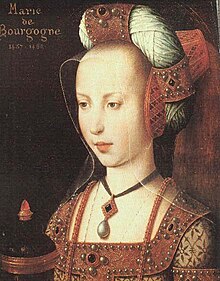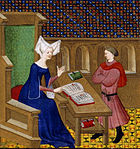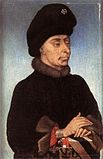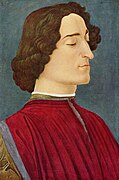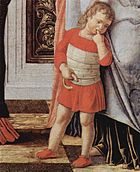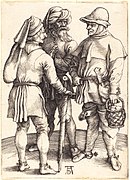
A chemise or shift is a classic smock type of women's undergarment or dress. Historically, a chemise was a simple garment worn next to the skin to protect clothing from sweat and body oils, the precursor to the modern shirts commonly worn in Western nations.

1830s fashion in Western and Western-influenced fashion is characterized by an emphasis on breadth, initially at the shoulder and later in the hips, in contrast to the narrower silhouettes that had predominated between 1800 and 1820.

An evening gown, evening dress or gown is a long dress usually worn at formal occasions. The drop ranges from ballerina, tea, to full-length. Such gowns are typically worn with evening gloves. Evening gowns are usually made of luxurious fabrics such as chiffon, velvet, satin, or organza. Silk is a popular fibre for many evening gowns. Although the terms are used interchangeably, ball gowns and evening gowns differ in that a ball gown will always have a full skirt and a fitted bodice, while an evening gown can be any silhouette—sheath, mermaid, fit and flare, A-line, or trumpet-shaped—and may have straps, halters or even sleeves.

A doublet is a man's snug-fitting jacket that is shaped and fitted to a man's body. The garment was worn in Spain, and spread to the rest of Western Europe, from the late Middle Ages up to the 17th century. Until the end of the 15th century, the doublet was usually worn under another layer of clothing such as a gown, mantle, or houppelande when in public. In the 16th century it was covered by the jerkin. Women started wearing doublets in the 16th century, and these garments later evolved as the corset and stay. The doublet was thigh length, hip length or waist length and worn over the shirt or drawers.
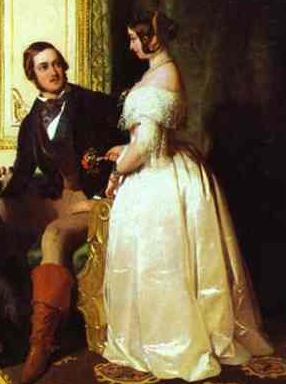
1840s fashion in European and European-influenced clothing is characterized by a narrow, natural shoulder line following the exaggerated puffed sleeves of the later 1820s and 1830s. The narrower shoulder was accompanied by a lower waistline for both men and women.

Fashion in the period 1550–1600 in European clothing was characterized by increased opulence. Contrasting fabrics, slashes, embroidery, applied trims, and other forms of surface ornamentation remained prominent. The wide silhouette, conical for women with breadth at the hips and broadly square for men with width at the shoulders had reached its peak in the 1530s, and by mid-century a tall, narrow line with a V-lined waist was back in fashion. Sleeves and women's skirts then began to widen again, with emphasis at the shoulder that would continue into the next century. The characteristic garment of the period was the ruff, which began as a modest ruffle attached to the neckband of a shirt or smock and grew into a separate garment of fine linen, trimmed with lace, cutwork or embroidery, and shaped into crisp, precise folds with starch and heated irons.

Fashion in the years 1750–1775 in European countries and the colonial Americas was characterised by greater abundance, elaboration and intricacy in clothing designs, loved by the Rococo artistic trends of the period. The French and English styles of fashion were very different from one another. French style was defined by elaborate court dress, colourful and rich in decoration, worn by such iconic fashion figures as Marie Antoinette.
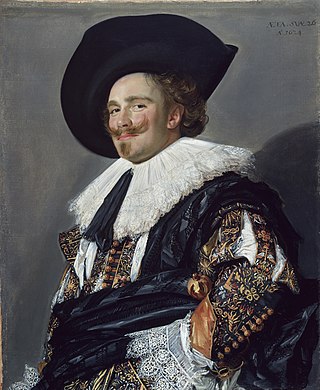
Fashion in the period 1600–1650 in Western clothing is characterized by the disappearance of the ruff in favour of broad lace or linen collars. Waistlines rose through the period for both men and women. Other notable fashions included full, slashed sleeves and tall or broad hats with brims. For men, hose disappeared in favour of breeches.

Fashion in the period 1650–1700 in Western clothing is characterized by rapid change. The style of this era is known as Baroque. Following the end of the Thirty Years' War and the Restoration of England's Charles II, military influences in men's clothing were replaced by a brief period of decorative exuberance which then sobered into the coat, waistcoat and breeches costume that would reign for the next century and a half. In the normal cycle of fashion, the broad, high-waisted silhouette of the previous period was replaced by a long, lean line with a low waist for both men and women. This period also marked the rise of the periwig as an essential item of men's fashion.
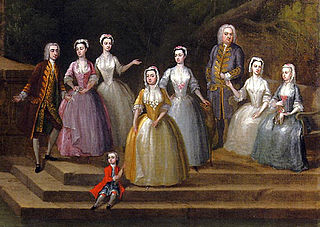
Fashion in the period 1700–1750 in European and European-influenced countries is characterized by a widening silhouette for both men and women following the tall, narrow look of the 1680s and 90s. This era is defined as late Baroque/Rococo style. The new fashion trends introduced during this era had a greater impact on society, affecting not only royalty and aristocrats, but also middle and even lower classes. Clothing during this time can be characterized by soft pastels, light, airy, and asymmetrical designs, and playful styles. Wigs remained essential for men and women of substance, and were often white; natural hair was powdered to achieve the fashionable look. The costume of the eighteenth century, if lacking in the refinement and grace of earlier times, was distinctly quaint and picturesque.

The hennin was a headdress in the shape of a cone, steeple, or truncated cone worn in the Late Middle Ages by European women of the nobility. They were most common in Burgundy and France, but also elsewhere, especially at the English courts, and in Northern Europe, Hungary and Poland. They were little seen in Italy. It is unclear what styles the word hennin described at the time, though it is recorded as being used in French areas in 1428, probably before the conical style appeared. The word does not appear in English until the 19th century. The term is therefore used by some writers on costume for other female head-dresses of the period.

Fashion in the period 1500–1550 in Europe is marked by very thick, big and voluminous clothing worn in an abundance of layers. Contrasting fabrics, slashes, embroidery, applied trims, and other forms of surface ornamentation became prominent. The tall, narrow lines of the late Medieval period were replaced with a wide silhouette, conical for women with breadth at the hips and broadly square for men with width at the shoulders. Sleeves were a center of attention, and were puffed, slashed, cuffed, and turned back to reveal contrasting linings.

Fashion in fourteenth-century Europe was marked by the beginning of a period of experimentation with different forms of clothing. Costume historian James Laver suggests that the mid-14th century marks the emergence of recognizable "fashion" in clothing, in which Fernand Braudel concurs. The draped garments and straight seams of previous centuries were replaced by curved seams and the beginnings of tailoring, which allowed clothing to more closely fit the human form. Also, the use of lacing and buttons allowed a more snug fit to clothing.

A dress is a one-piece outer garment that is worn on the torso and hangs down over the legs and is primarily worn by women or girls. Dresses often consist of a bodice attached to a skirt.

Costume during the thirteenth century in Europe was relatively simple in its shapes, rich in colour for both men and women, and quite uniform across the Roman Catholic world as the Gothic style started its spread all over Europe in dress, architecture, and other arts.

Twelfth century European fashion was simple in cut and differed only in details from the clothing of the preceding centuries, starting to become tighter and more similar for men and women as the century went on, which would continue in the 13th century. Men wore knee-length tunics for most activities, and men of the upper classes wore long tunics, with hose and mantle or cloaks. Women wore long tunics or gowns. A close fit to the body, full skirts, and long flaring sleeves were characteristic of upper-class fashion for both men and women.
The Medieval period in England is usually classified as the time between the fall of the Roman Empire to the beginning of the Renaissance, roughly the years AD 410–1485. For various peoples living in England, the Anglo-Saxons, Anglo-Danes, Normans and Britons, clothing in the medieval era differed widely for men and women as well as for different classes in the social hierarchy. The general styles of Early medieval European dress were shared in England. In the later part of the period, men's clothing changed much more rapidly than women's styles. Clothes were very expensive, and both men and women were divided into social classes by regulating the colors and styles that various ranks were permitted to wear. In the early Middle Ages, clothing was typically simple and, particularly in the case of lower-class peoples, served only basic utilitarian functions such as modesty and protection from the elements. As time went on the advent of more advanced textile techniques and increased international relations, clothing gradually got more and more intricate and elegant, even with those under the wealthy classes, up into the renaissance.

The history of Italian fashion is a chronological record of the events and people that impacted and evolved Italian fashion into what it is today. From the Middle Ages, Italian fashion has been popular internationally, with cities in Italy producing textiles like velvet, silk, and wool. During the Middle Ages and Renaissance, Italian fashion for both men and women was extravagant and expensive, but the fashion industry declined during the industrialization of Italy. Many modern Italian fashion brands were founded in the late 19th and early 20th centuries, and in the 1950s and 1960s, Italian fashion regained popularity worldwide. While many clients of Italian fashion designers are celebrities, Italian fashion brands also focus on ready-to-wear clothes.

Fashion in the twenty years between 1775 and 1795 in Western culture became simpler and less elaborate. These changes were a result of emerging modern ideals of selfhood, the declining fashionability of highly elaborate Rococo styles, and the widespread embrace of the rationalistic or "classical" ideals of Enlightenment philosophes.

A partlet was a 16th-century fashion accessory. The partlet was a sleeveless garment worn over the neck and shoulders, either worn over a dress or worn to fill in a low neckline.




![Giovanna Tornabuoni [it] and her attendants in Italian fashion of the 1480s. The tight slashed sleeves reveal the full chemise sleeves beneath. She wears a giornea over a kirtle or gamurra. Giovanna Tornabuoni full length.jpg](http://upload.wikimedia.org/wikipedia/commons/thumb/c/ca/Giovanna_Tornabuoni_full_length.jpg/220px-Giovanna_Tornabuoni_full_length.jpg)
